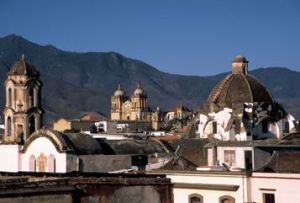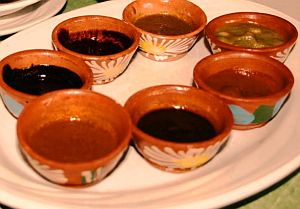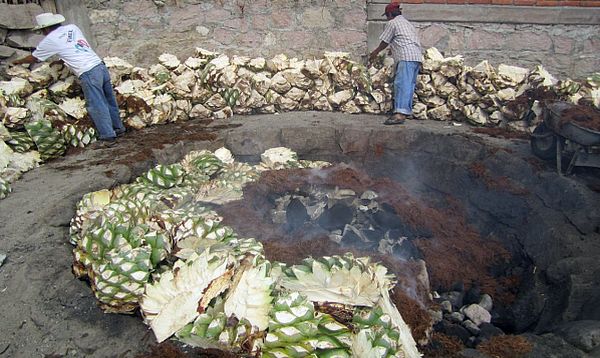Oaxaca, Mexico - You can literally follow the smell of roasting agave hearts down the side roads to small backyard stills. Cuervo country, this is not.
At a time when its agave-based relation, tequila, is all about business and marketing, mezcal manufacturers are family-owned and bottled by hand. Mezcal will take you into the heart of Oaxaca and give you a sneak peek at an increasingly cherished Mexican tradition. Quality mezcal is produced throughout Mexico, but it's woven into the fabric of Oaxaca, the capital city of the state with the same name which is known for its art, cuisine, and spiritual traditions.
The drink is everywhere: On a recent night at alternative art space Cafecute Central, 50 hipsters sipped mezcal at a free screening of German indie film "The Robber." Backpackers stay at Hostel Mezkalito. Agave plants adorn churches, schools, hotels, and museums. Children eat mezcal sherbet. A popular saying here is Para todo mal, mezcal; para todo bien, tambien - "For everything bad, mezcal, for everything good, the same."
 |
Oaxaca itself, a colonial city of 250,000, has both the insular, naughty feel of a college town and the weighty cultural history of a European capital. Nestled in a mountain valley, it is minutes away from some of the most spectacular vistas in the Americas, and many miles and mind-sets away from the spring-break crowd. Oaxaca is the Mexico that guidebooks promise – rich in tradition, picturesque, and lively. To begin, just find some mezcal.
The Liquor
"Mezcal, mezcal legitimo!" says Juan Martinez, dragging a hand truck up a cobblestone street in downtown Oaxaca. For a few bucks, I buy a two-liter Coke bottle filled with top-notch mezcal distilled from agave that grows wild in the mountain town of San Juan Del Rio. "I made it yesterday," he says.
Martinez seems lifted from a faded postcard, but his mezcal may soon be in a $15 margarita near you.
Mezcal is a distillate made from any species of agave plant, where the agave hearts are slow-roasted over wood fires before being crushed and distilled - giving the drink a complexity akin to single malts. Tequila is one type of mezcal, made from "blue" agave, steamed and distilled for clarity and refinement.
Unlike tequila, mezcal is produced as it has been for centuries, at distilleries such as Destilería Los Danzantes, one of the more sophisticated operations; it has a phone, a tasting room, and a website. Agave hearts harvested nearby are roasted for days in a pit, crushed by a horse towing a massive stone wheel, left to ferment in wooden vats, and distilled in copper pots. The distillery's mezcal is widely available in the United States, yet its bottling facility includes a 5-gallon plastic water dispenser on an office desk. To visit other operations, skip the tourist buses and hire a culinary guide, or ask at one of the mezcal bars downtown.
"You can't just hit someplace on the main road," says Alvin Starkman, a Canadian expat who gives culinary tours. "You need to go to three or four places to see the diversity."
The Food
 |
Oaxaca is sometimes called "land of the seven moles," although there are actually countless versions of the elaborate chile sauce that embodies the region's famously complex cuisine. At Pitiona, chef José Manuel Bantildeos Rodriguez mixes molecular gastronomy know-how with traditional Oaxacan recipes to create a six-course tasting menu – with matching mezcals – including bean foam and carrot tortillas set with gelatinous, algae-derived agar-agar.
The courtyard of La Biznaga restaurant is a perfect place to wait out the summer rains and enjoy $2 local house mezcals alongside octopus salad with rosemary and white beans. This ties beautifully into steak with a sumptuous, jet-black sauce of plums, mezcal, and the smoked pasilla mixe chile.
Zandunga serves food from the isthmus of Tehuantepec, in the southeastern part of Oaxaca state. Its beef and fish stews are fantastic, but the huge appetizer platter — with fried plantain dumplings, sweet beef tamales, hunks of braised beef garnished with red chile, small tostadas, and tomato salsa with dried shrimp – accompanied by house mezcals and Mexican microbrews — is paradise.
The Bars
Despite its relaxed vibe, Oaxaca is a city that likes to celebrate. There are after-hours dance clubs, beer bars with 100-year-old saloon doors, and easy-to-miss storefronts with agave ambassadors sharing the local bounty. It's easy to get lost in the downtown bars.
Mezcaleria Los Amantes is a dark, arty mezcal dispenser devoted to small-production mezcals. Txalaparta is high energy, with its late-night, mezcal-fueled dance parties. Or kick back at La Salamandra, a cozy neighborhood bar with live music.
At La Mezcaloteca, an appointment-only tasting room, owners Marco Ochoa and Silvia and Alejandro Philon are dedicated to educating the public about the individuality of traditional mezcals. Ochoa takes a deep whiff of a 104-proof mexicano that exudes green olive, tobacco, and a hint of mushroom. He lets out a satisfied sigh: "It's alchemy."


